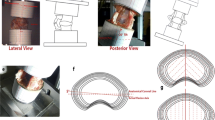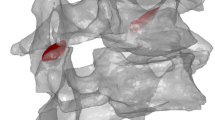Abstract
Purpose
To date, the mechanisms of disc failure have been explored at a microstructural level in relatively simple postures. However, in vivo the disc is known to be subjected to complex loading in compression, bending and shear, and the influence of these factors on the mechanisms of disc failure is yet to be described at a microstructural level. The purpose of this study was to provide a microstructural analysis of the mechanisms of failure in healthy discs subjected to compression while held in a complex posture incorporating physiological amounts of flexion and facet-constrained shear.
Methods
30 motion segments from 10 healthy mature ovine lumbar spines were compressed in a complex posture intended to simulate the situation arising when bending and twisting while lifting a heavy object, and at a displacement rate of 40 mm/min. Nine of the 30 samples reached the predetermined displacement prior to a reduction in load and were classified as early-stage failures, providing insight into initial areas of disc disruption. Both groups of damaged discs were then analysed microstructurally using light microscopy.
Results
Complex postures significantly reduced the load required to cause disc failure than earlier described for flexed postures [8.42 kN (STD 1.22 kN) compared to 9.69 kN (STD 2.56 kN)] and resulted in a very different failure morphology to that observed in either simple flexion or direct compression, involving infiltration of nucleus material in a circuitous path to the annular periphery.
Conclusion
The complex posture as used in this study significantly reduced the load required to cause disc failure, providing further evidence that asymmetric postures while lifting should be avoided if possible.









Similar content being viewed by others
References
Farfan HF, Cossette JW, Robertson GH, Wells RV, Kraus H (1970) The effects of torsion on the lumbar intervertebral joints: the role of torsion in the production of disc degeneration. J Bone Jt Surg Am 52:468–497
Marras WS, Lavender SA, Leurgans SE, Rajulu SL, Allread WG, Fathallah FA, Ferguson SA (1993) The role of dynamic three-dimensional trunk motion in occupationally-related low back disorders. The effects of workplace factors, trunk position, and trunk motion characteristics on risk of injury. Spine (Phila Pa 1976) 18(5):617–628
Fathallah FA, Marras WS, Parnianpour M (1998) The role of complex, simultaneous trunk motions in the risk of occupation-related low back disorders. Spine 23(9):1035–1042
Qasim M, Natarajan RN, An HS, Andersson GBJ (2012) Initiation and progression of mechanical damage in the intervertebral disc under cyclic loading using continuum damage mechanics methodology: a finite element study. J Biomech 45(11):1934–1940. doi:10.1016/j.jbiomech.2012.05.022
Casaroli G, Villa T, Bassani T, Berger-Roscher N, Wilke HJ, Galbusera F (2017) Numerical prediction of the mechanical failure of the intervertebral disc under complex loading conditions. Materials. doi:10.3390/ma10010031
Schmidt H, Heuer F, Wilke HJ (2009) Dependency of disc degeneration on shear and tensile strains between annular fiber layers for complex loads. Med Eng Phys 31(6):642–649. doi:10.1016/j.medengphy.2008.12.004
Wade KR, Robertson PA, Thambyah A, Broom ND (2014) How healthy discs herniate: a biomechanical and microstructural study investigating the combined effects of compression rate and flexion. Spine 39(13):1018–1028
Yoganandan N, Maiman DJ, Pintar F, Ray G, Myklebust JB, Sances A Jr, Larson SJ (1988) Microtrauma in the lumbar spine: a cause of low back pain. Neurosurgery 23(2):162–168
Roaf R (1960) A study of the mechanics of spinal injuries. J Bone Jt Surg Br 42-B(4):810–823
Lundin O, Ekström L, Hellström M, Holm S, Swärd L (1998) Injuries in the adolescent porcine spine exposed to mechanical compression. Spine 23(23):2574–2579
Adams MA (1995) Spine update: mechanical testing of the spine: an appraisal of methodology, results, and conclusions. Spine 20(19):2151–2156
Adams MA, Hutton WC (1982) Prolapsed intervertebral disc: a hyperflexion injury. Spine 7(3):184–191
Wade KR, Robertson PA, Thambyah A, Broom ND (2015) ‘Surprise’ loading in flexion increases the risk of disc herniation due to annulus–endplate junction failure: a mechanical and microstructural investigation. Spine 40(12):891–901. doi:10.1097/BRS.0000000000000888
Wilke HJ, Kienle A, Maile S, Rasche V, Berger-Roscher N (2016) A new dynamic six degrees of freedom disc-loading simulator allows to provoke disc damage and herniation. Eur Spine J 25(5):1363–1372. doi:10.1007/s00586-016-4416-5
Berger-Roscher N, Casaroli G, Rasche V, Villa T, Galbusera F, Wilke HJ (2017) Influence of complex loading conditions on intervertebral disc failure. Spine 42(2):E78–E85. doi:10.1097/BRS.0000000000001699
Veres SP, Robertson PA, Broom ND (2009) The morphology of acute disc herniation: a clinically relevant model defining the role of flexion. Spine (Phila Pa 1976) 34(21):2288–2296. doi:10.1097/BRS.0b013e3181a49d7e
Veres SP, Robertson PA, Broom ND (2010) ISSLS prize winner: how loading rate influences disc failure mechanics: a microstructural assessment of internal disruption. Spine (Phila Pa 1976) 35(21):1897–1908. doi:10.1097/BRS.0b013e3181d9b69e
Veres SP, Robertson PA, Broom ND (2010) The influence of torsion on disc herniation when combined with flexion. Eur Spine J 19(9):1468–1478. doi:10.1007/s00586-010-1383-0
Kelsey JL, Githens PB, White AA (1984) An epidemiologic study of lifting and twisting on the job and risk for acute prolapsed lumbar intervertebral disc. J Orthop Res 2(1):61–66
Reid JE, Meakin JR, Robins SP, Skakle JMS, Hukins DWL (2002) Sheep lumbar intervertebral discs as models for human discs. Clin Biomech 17(4):312–314
Smit TH (2002) The use of a quadruped as an in vivo model for the study of the spine—biomechanical considerations. Eur Spine J 11(2):137–144
Wilke HJ, Kettler A, Claes LE (1997) Are sheep spines a valid biomechanical model for human spines? Spine 22(20):2365–2374
Race A, Broom ND, Robertson P (2000) Effect of loading rate and hydration on the mechanical properties of the disc. Spine 25(6):662–669
Lin HS, Liu YK, Adams KH (1978) Mechanical response of the lumbar intervertebral joint under physiological (complex) loading. J Bone Jt Surg Ser A 60 A(1):41–55
Schmidt H, Galbusera F, Rohlmann A, Shirazi-Adl A (2013) What have we learned from finite element model studies of lumbar intervertebral discs in the past four decades? J Biomech 46(14):2342–2355. doi:10.1016/j.jbiomech.2013.07.014
Broberg KB (1983) On the mechanical behaviour of intervertebral discs. Spine 8(2):151–165
van Heeswijk VM, Thambyah A, Robertson PA, Broom ND (2017) Posterolateral disc prolapse in flexion initiated by lateral inner annular failure: an investigation of the herniation pathway. Spine. doi:10.1097/BRS.0000000000002181
Schmidt H, Häußler K, Wilke HJ, Wolfram U (2015) Structural behavior of human lumbar intervertebral disc under direct shear. J Appl Biomater Funct Mater 13(1):66–71. doi:10.5301/jabfm.5000176
Adams MA, Hutton WC (1985) Gradual disc prolapse. Spine 10(6):524–531
Stefanakis M, Luo J, Pollintine P, Dolan P, Adams MA (2014) ISSLS Prize winner: mechanical influences in progressive intervertebral disc degeneration. Spine 39(17):1365–1372. doi:10.1097/BRS.0000000000000389
Green TP, Adams MA, Dolan P (1993) Tensile properties of the annulus fibrosus. II. Ultimate tensile strength and fatigue life. Eur Spine J 2(4):209–214
Noguchi M, Gooyers CE, Karakolis T, Noguchi K, Callaghan JP (2016) Is intervertebral disc pressure linked to herniation?: An in vitro study using a porcine model. J Biomech 49(9):1824–1830. doi:10.1016/j.jbiomech.2016.04.018
Rajasekaran S, Bajaj N, Tubaki V, Kanna RM, Shetty AP (2013) ISSLS prize winner: the anatomy of failure in lumbar disc herniation: an in vivo, multi-modal, prospective study of 181 subjects. Spine 38(17):1491–1500
Acknowledgements
The authors gratefully acknowledge funding support from NuVasive and Medtronic (Australasia).
Author information
Authors and Affiliations
Corresponding author
Ethics declarations
Conflict of interest
None.
Rights and permissions
About this article
Cite this article
Wade, K.R., Schollum, M.L., Robertson, P.A. et al. A more realistic disc herniation model incorporating compression, flexion and facet-constrained shear: a mechanical and microstructural analysis. Part I: Low rate loading. Eur Spine J 26, 2616–2628 (2017). https://doi.org/10.1007/s00586-017-5252-y
Received:
Revised:
Accepted:
Published:
Issue Date:
DOI: https://doi.org/10.1007/s00586-017-5252-y




